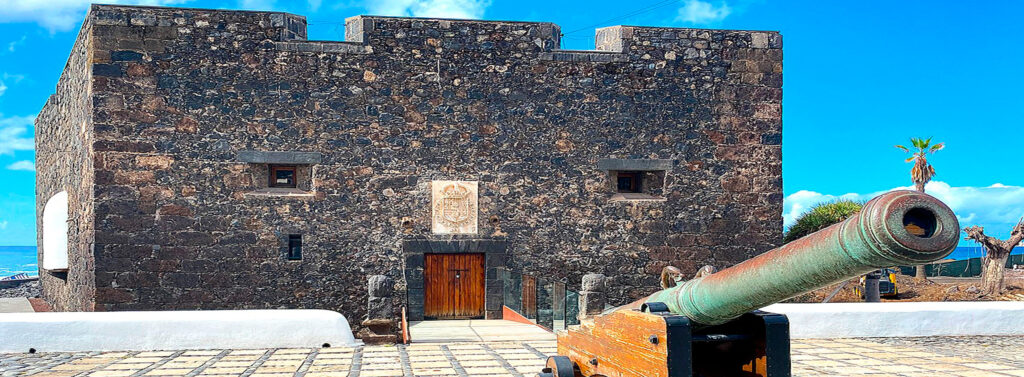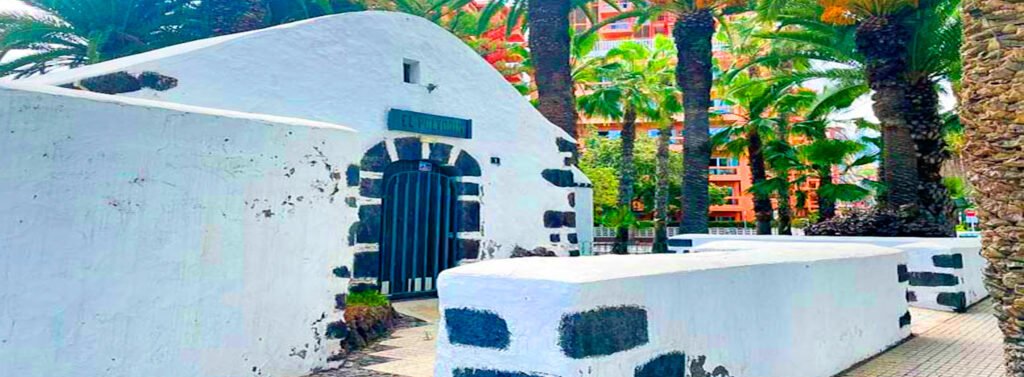– Accommodation “Castillo de San Felipe” and “El Polvorín”: A tribute to the history of Puerto de la Cruz –
Our holiday flats “Castillo de San Felipe” and “El Polvorín”, inaugurated in 2024, have been carefully named after two iconic monuments of Puerto de la Cruz, with the intention of connecting our guests experience with the rich historical heritage of the city.
The Castillo de San Felipe is a fortress built in the 17th century to defend the coast from pirate attacks, representing for centuries the strength and protection of Puerto de la Cruz. Inspired by this symbol of security, we have named one of our flats “Castillo de San Felipe”, a place where you can enjoy a quiet, safe stay with all the comfort you need to rest.
The Polvorín, on the other hand, was the place where munitions were stored for the defence of the castle, being a key piece in the resistance and preservation of the city. This place, full of history, has given its name to our second flat, “El Polvorín”, a space that invites you to recharge your batteries and enjoy the vitality that characterises Puerto de la Cruz.
Just as these two monuments are connected by their strategic and historical value, our flats are also designed to offer an experience that combines comfort, history and the essence of Puerto de la Cruz. We invite you to immerse yourself in the tradition and beauty of the city, enjoying accommodation that pays homage to its past while offering you all the comforts of the present.
– History of San Felipe Castle –

The Castle of San Felipe is one of the most emblematic defensive structures in the town of Puerto de la Cruz, on the island of Tenerife (Canary Islands). Its history is linked to the protection of the Tenerife coast during the period when the islands were vulnerable to pirate attacks and other threats from the sea.
Origins and construction
The Castle of San Felipe was built between 1641 and 1655, in response to the security concerns of the time, as Tenerife, like other Canary Islands, suffered pirate raids and attacks by foreign forces. In those years, the Spanish Crown, aware of the strategic importance of the islands, decided to reinforce the defences at different key points of the archipelago.
Located near the mouth of a ravine and the coast, the castle was designed as a small fortification with a simple but effective defence structure. It is square in plan, with walls of thick dark volcanic stone, typical of the region, giving it a robust and austere appearance. Originally, it was equipped with cannons that could repel attacks from the sea.
Defensive function
Throughout its history, the Castle of San Felipe played an important role in the defence of Puerto de la Cruz, which at the time was a key port for trade and fishing. Its strategic position allowed it to keep watch for possible incursions and to protect both the port and the nearby villages.
Despite its modest size, it fulfilled its function as part of the network of towers and fortifications that defended the Canary Islands from foreign invasions. Over time, especially after the 19th century, the threat of pirate attacks diminished and the castle lost its military relevance.
Contemporary use and restoration
In the 20th century, the Castle of San Felipe was restored and declared an Asset of Cultural Interest. It no longer has a military use, but has become an important cultural space for the municipality. Art exhibitions, concerts and cultural events are held inside, which has revitalised its role in the community.
Today, the Castle of San Felipe remains a place of great historical and cultural interest in Tenerife, recalling its defensive past and serving as an important tourist attraction in Puerto de la Cruz.
Architectural features
Building material: Dark volcanic stone.
Plant: Square.
Current functions: Cultural space (exhibitions, concerts).
Location: Close to the coast, overlooking the ocean.
The castle, although small in comparison with other fortifications, remains a symbol of Tenerife’s rich military history and the strategic importance of the Canary Islands over the centuries.
– History of El Polvorín –

The Polvorín of Puerto de la Cruz is a historic structure which, although less well known than the Castle of San Felipe, also forms part of the military and architectural heritage of the municipality. Its history is linked to the defensive use of Puerto de la Cruz and the strategic needs of the island of Tenerife during past centuries, particularly during the times when the threat of pirate attacks and other foreign incursions was a constant concern for the local authorities.
Origin and function
The gunpowder magazine was a facility for storing gunpowder and ammunition for the artillery and cannons that defended the coast. It was built as a safe military warehouse, far from the town centre, to avoid accidents or explosions that could endanger the population.
As Puerto de la Cruz was strategically located, and given the importance of the coastal defences, it was essential to have facilities such as this magazine. The gunpowder and ammunition stored there was supplied to nearby fortifications, such as the Castillo de San Felipe, in times of need. Having a gunpowder magazine nearby allowed quick access to military resources, essential for the defence of the city and its port.
Architecture and location
The Puerto de la Cruz Powder Magazine is a rectangular building with thick walls of volcanic stone, similar to other defensive constructions of the time in Tenerife. The architectural features of the building were specifically designed to keep the gunpowder in stable conditions, isolated from humidity and the risk of fire. In addition, its structure was designed to minimise the impact of a possible explosion, which is why it was located at a prudent distance from the most populated areas.
Although not a monumental building, the powder magazine is of strategic importance in the defence system of the region.
Recent history and current use
With the passage of time and the decrease in external military threats to the island, the Polvorín gradually lost its original function, falling into disuse as a military installation. Like the Castillo de San Felipe, the relevance of this type of building declined as Tenerife became integrated into a more secure geopolitical context.
In recent times, the powder magazine has been of historical and cultural interest. Although it does not have as prominent a cultural use as the Castillo de San Felipe, it has been recognised as part of the heritage of Puerto de la Cruz. Efforts have been made to preserve its structure and make it a testimony to the city’s military past.
Today, the Powder Magazine of Puerto de la Cruz is considered an Asset of Cultural Interest and forms part of the city’s historical tourist routes, helping to preserve the memory of the ancient defences of Puerto de la Cruz and its role in the history of the island.
Importance in the local context
The powder magazine is a key piece in understanding the defensive system that existed in Tenerife in the 17th and 18th centuries. Although smaller than other structures, its function was vital for military logistics, providing the necessary ammunition to repel possible attacks. It also represents the daily life of the garrisons and the island’s defence in times of insecurity on the Canary Islands’ coasts.
Conclusion
The Powder Magazine of Puerto de la Cruz is a reminder of the military history of the municipality and how the city was prepared to face the threats of the sea. Although it is not as well known or visited as the Castillo de San Felipe, it is an integral part of Tenerife’s military heritage.
